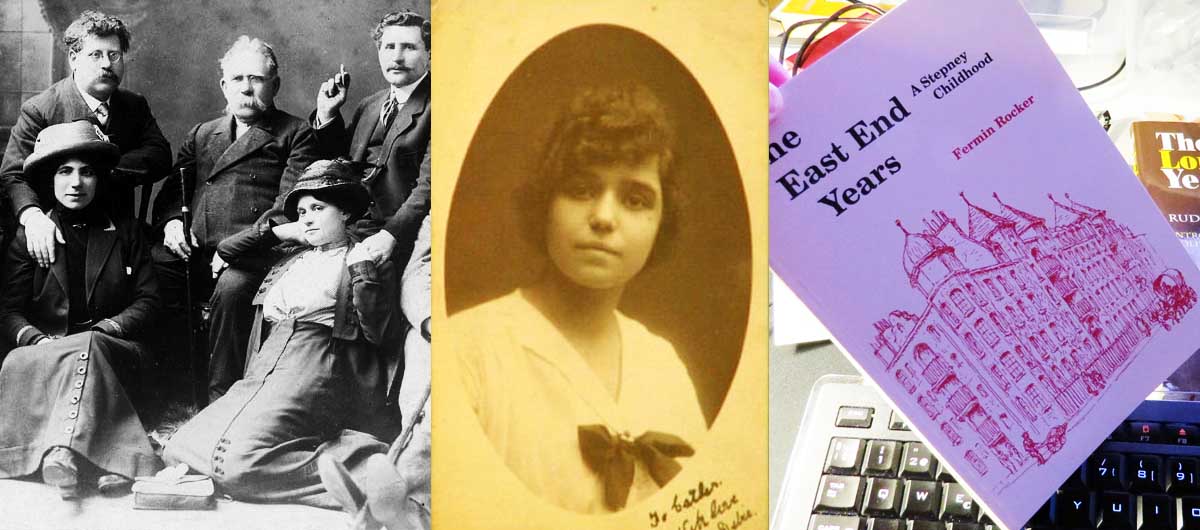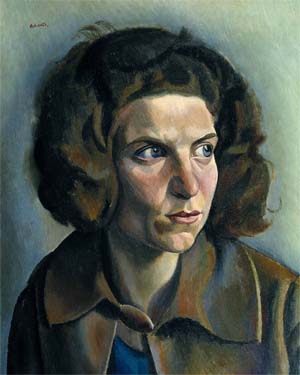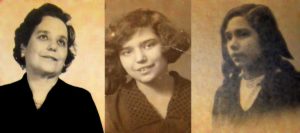Debbie Jimack was my grandmother’s maiden name. Back at the end of July I published a memoir of her, which you can read here. A couple of months later I received an e-mail through this site’s contact page pointing me to photos of Debbie on a Dutch website. This triggered a fascinating paper chase over the last two months, during which I learned much more about her early years. It also gave me the satisfaction of finding a couple of linking pieces in the jigsaw puzzle that is my family’s collective memory of the stories she used to tell.
To the East End
Debbie was born in the Black Sea city of Odessa. Now in Ukraine, Odessa was then a part of the Jewish Pale of Settlement of the Russian Empire. The Jews of the Pale faced repeated ethnic violence known to history as pogroms. Wikipedia tells me the first recorded pogrom actually took place in Odessa in 1821. After the assassination of Tsar Alexander II in 1888 (an act of terror that was blamed on Jews without much reason), the pogroms intensified.
In 1900, like so many Jewish families, the Jimacks fled Russia to the relative safety of England. They ended up in the Jewish quarter of London’s East End.
As a family, we knew Grandma grew up in the East End. My mother remembers her grandmother, but obviously her memories (she was born in 1922) come from much later.
Grandma was as old as the century, she liked to say. I found the family’s census record from 1911, and there she is, aged 11 and still at school. A “Jewess”, born in Russia but resident at 70 Langdale Mansions in the parish of St George-in-the-East, now in Tower Hamlets. Her mother is Annie, her father Benjamin, and there are six brothers. The eldest, “John” (remembered in the family as Jack/Jacob), was 18. The youngest, at 8 months, was Louis/Lewis, later known as Jimmy. The family of 9 was crowded together in 3 rooms.
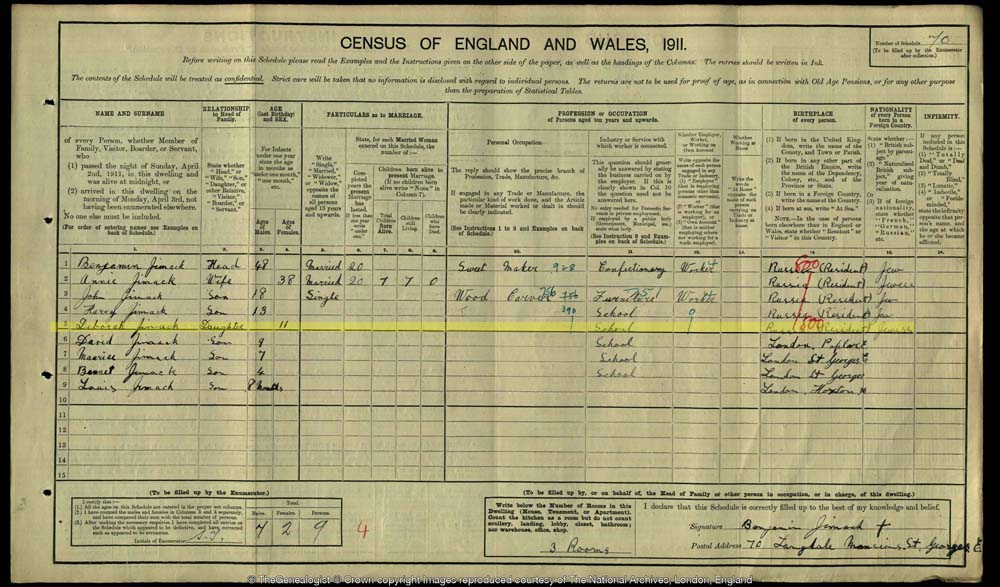
Debbie Jimack in a Dutch Archive
Towards the end of September I received an e-mail from David Mazower writing from the Yiddish Book Center in the USA. David wrote…
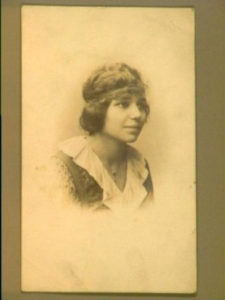
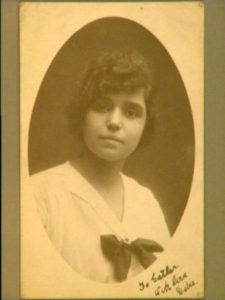
Enjoyed reading about your grandmother. Just wanted to be sure you knew about these beautiful photos of her in the archives of the International Institute of Social History, Amsterdam:
https://search.iisg.amsterdam/Record/1041469
https://search.iisg.amsterdam/Record/1041500
Interesting that they are there in the Rudolf Rocker archives, because that suggests an association with Rocker.
They are beautiful pictures, and to be one hundred percent sure they are of Grandma (as if there was anyone else in the world called Debbie Jimack in 1915), the collection also includes a copy of the 1920 photo of Debbie with my grandfather Charles Bradshaw Warwick (aka “Charlie B”, aka “Carlo”), which I also have a copy of. (Though I thought it was from 1922.)
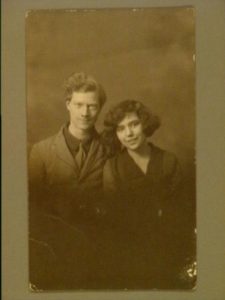
As David M wrote, finding the photos in the collection suggests a Rudolf Rocker connection. And there is. There’s a story that Debbie’s first boyfriend was called Rudolf. That he was interned as an enemy alien at Alexandra Palace during the First World War, and that she used to visit him there. Mum has an elaborately carved little wooden box that “was made by a prisoner at Alexandra Palace”.
Who was Rudolf Rocker?
Rudolf Rocker was a German anarchist, a political theorist, a writer, editor and typesetter. He was all these things by the age of 20 – in 1893. That was when he left Germany for Paris one step ahead of the police and to avoid conscription. One thing he was not, was Jewish. But in Paris and later in England he came in contact with Jewish anarchists and eventually taught himself Yiddish in order to be able to set Yiddish type and print radical newspapers and magazines.
One of the books I’ve read in the last couple of months is Rocker’s autobiographical account of his 20 odd years in England, The London Years. It bears the hallmarks of having been assembled from writings he made at different times and for different purposes. Still, it’s all interesting and some parts of it give fascinating pictures of life in the East End at the time, and of individuals he knew. (The Russian aristocratic anarchist Kropotkin and the Italian anarchist Errico Malatesta, for example.)
One of Rocker’s experiences stands out; his failed attempt to emigrate to the USA with his Jewish partner Milly Witcop. The two never married and because of this were turned back at Ellis Island and returned to London. (An action which attracted a deal of newspaper attention in the USA.)
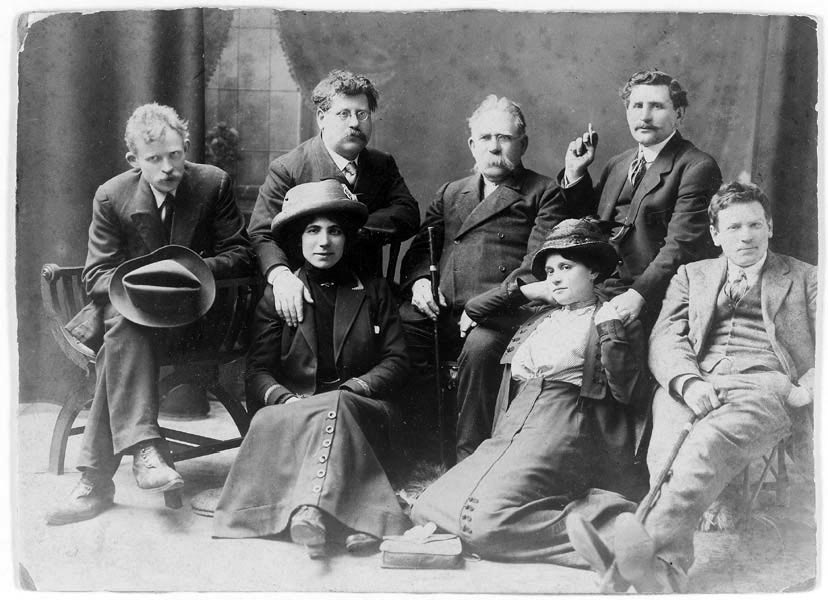
Enemy alien
Following the outbreak of war in 1914, he was arrested and interned. Officially because he was an “enemy alien”, in all probability because he was an outspoken pacifist with a large following in the Jewish community. He was imprisoned first at Earls Court, then on a ship off Southend and finally, for much of the war, at Alexandra Palace. Where, indeed, his family and friends were able to visit him.
But was he Grandma’s boyfriend? The more I read, the more unlikely it seemed. Apart from anything else, the age difference was colossal. When Debbie was 15, Rocker would have been 42. More than that, it seems Rocker’s partnership with Milly Witcop was very solid. They lived together (when possible) to the day of her death in 1955.
Rudolf junior
Fortunately for Grandma’s story, Rudolf Rocker had a son, also Rudolf Rocker, who was just 20 when war broke out. A much more likely boyfriend candidate. Rudolf junior was born to Rocker and a French woman he lived with in Paris before moving to London and meeting Milly. After the boy’s sixth birthday, his mother sent him to live with his father in London. “My son Rudolf” makes a couple of fleeting appearances in The London Years. But he features larger in another book I’ve been reading.
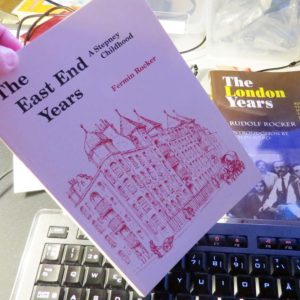
With Milly, Rudolf senior had a second son, Fermin Rocker, who also wrote an autobiographical account of his London years. This is The East End Years: A Stepney Childhood.
Fermin Rocker was an artist and his Stepney Childhood is illustrated with drawings of people and incidents, including several of his father. There’s one (page 30) I think must be his brother, though it’s not clearly identified as such in the caption. However, Fermin describes Rudolf jnr. as tall, well-proportioned, [with] finely chiselled features, blond hair and blue eyes…
Admiring young females
For a number of years Rudolf junior helped to run a Sunday school which carried out educational work for the Jewish socialist movement. He was a hit with the young female students. As far back I can remember, Fermin writes, Rudolf was surrounded by a coterie of admiring young females, mostly pupils of his.
Reading the above, I was thinking this was probably the origin of Debbie’s Rudolf-as-boyfriend story. I doubted I’d get any more detail. But then, in Chapter 13 (page 128) I found her. Rudolf junior travelled with his father to Canada in 1913, staying on when his father returned. After a year in Toronto though, just before the outbreak of war, he returned.
After his return from Canada, Rudolf … lost no time reopening his Sunday class … Although he was popular with all his students it was among the girls that he found his most ardent devotees, a not altogether surprising phenomenon. Surprising, perhaps, was his ability to steer clear of serious involvement with any of his admirers. Only towards the end of his stay in London was there a hint of such a possibility. Debbie, a slim, attractive, curly haired brunette, was the girl in question. He somehow seemed more partial to her than to anyone else …
Imagine me, if you will, dancing around the table in celebration after finding this passage.
A short-lived affair
Fermin goes on to write that the affair was a most harmless and short-lived one. No sooner had Rudolf left the country than Debbie was forgotten. To underline this, there’s a photo at the back of the book showing Rudolf junior with his wife Charlotte in Berlin in 1922.
The affair may have been “short-lived” in one sense, but I can’t make it out to have been less than eighteen months. Perhaps longer. In my mind, she met Rudolf junior in his Sunday school sometime between the autumn of 1914 and the spring of 1916. Left at large by the authorities, despite his nationality, he was not arrested until July 1916. (Milly was arrested the same day, and Fermin was taken in by his aunt and uncle, Polly and Lazar Sabel.) After that he spent most of the rest of the war at Alexandra Palace with his father.
Rudolf Rocker senior was eventually sent via the Netherlands to Germany (March 1918), but what happened to Rudolf junior I can’t say. All I know (from the photo at the back of Stepney Childhood) is that he was in Berlin in 1922. In the face of no information to the contrary, I assume he wasn’t sent to Germany with his father, but left England some time after. That would mean Debbie Jimack’s “short-lived” affair with him lasted – at least – from 1916 to 1918.
Esther?
There’s more. The three photos in the Dutch archive are all signed “To Esther”. So who is Esther, and what connection did she have with the Rockers?
I’m on more shaky ground here, but my mother and sister nominate Esther Lahr. Born Esther Argeband, later Archer, Esther was Debbie Jimack’s “best friend from school”. Esther was two years Debbie’s elder, so now I’m wondering if “school” in this context was actually Rudolf junior’s Sunday school. In 1922, Esther married Karl (Charles) Lahr, another non-Jewish German revolutionary drawn into the Jewish anarchist circle around Rocker. During the war, Lahr was interned (another enemy alien) at Alexander Palace, where he acted as Rudolf Rocker senior’s secretary. He also makes a few fleeting appearances in The London Years.
In my imagination, Debbie gave Esther her photos and Esther passed them on to Rudolf junior, which is how they ended up in the Rocker archive in Amsterdam. Alternatively, some of Charles Lahr’s private papers – including these photos – were accidentally included with Rocker’s papers at some point. But I prefer the first interpretation.
Quite a ride
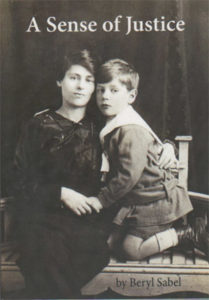
Almost all the above are things I’ve learned only in the last couple of months. It’s been quite a ride. There may be a bit more to come. (Things to be learned; a bit more riding to do.)
My cousin Michael is the only one of the second generation Jimacks still around. (Apart, that is, from my 98 year old mother.) Michael turned 90 this year and has been holed up at home throughout the Covid crisis. I’ve been able to talk with him on the phone a few times and discussed what I’ve uncovered. He’s put me in touch with a cousin on his mother’s side. She turns out to be a member of the Sabel family.
Beryl Sabel has written a novel based on her family’s story: A Sense of Justice. So now I have that on order. (The book is privately published, so there’s no link to share and this is the only image I’ve been able to find of the front cover.)
So that’s where I’m at in respect of Debbie Jimack. I wonder if there’ll be a third chapter? Watch this space!
Thanks
My thanks are due to David Mazower for drawing my attention to Debbie’s photos in the Rocker archive of the International Institute of Social History in Amsterdam.
Thanks also to Philip Rocker for responding to my e-mails about his uncle Rudolf junior, eternally lost (I suspect) in the waters of history. You can see some of Fermin Rocker’s art here.
Thanks to my mother, sister and Michael Jimack for interesting snippets of information, contacts and ideas that have helped my searches.
Images are: Screenshot of Census return for Jimack family 1911; the three pictures of Debbie in the Rocker Archives of the International Institute of Social History, Amsterdam (links in the text); Rudolf Rocker, Milly Witcop and London Anarchists in 1912 from Wikimedia Commons (click on the photo to see original); covers of autobiographies by Fermin Rocker and Rudolf Rocker senior mentioned in text; low res JPG of William Roberts’ portrait of Esther Lahr in the Tate’s collection (click on the photo to see the original); cover of Beryl Sabel’s A Sense of Justice reproduced from a 2010 blog post on the Felixstowe Scribbler’s website.

